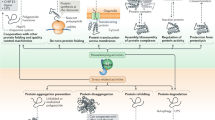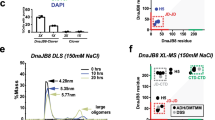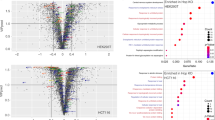Abstract
To maintain quality control in cells, mechanisms distinguish among improperly folded peptides, mature and functional proteins, and proteins to be targeted for degradation. The molecular chaperones, including heat-shock protein Hsp90, have the ability to recognize misfolded proteins and assist in their conversion to a functional conformation. Disruption of Hsp90 heterocomplexes by the Hsp90 inhibitor geldanamycin leads to substrate degradation through the ubiquitin–proteasome pathway1,2,3, implicating this system in protein triage decisions. We previously identified CHIP (carboxyl terminus of Hsc70-interacting protein) to be an interaction partner of Hsc70 (ref. 4). CHIP also interacts directly with a tetratricopeptide repeat acceptor site of Hsp90, incorporating into Hsp90 heterocomplexes and eliciting release of the regulatory cofactor p23. Here we show that CHIP abolishes the steroid-binding activity and transactivation potential of the glucocorticoid receptor, a well-characterized Hsp90 substrate5, even though it has little effect on its synthesis. Instead, CHIP induces ubiquitylation of the glucocorticoid receptor and degradation through the proteasome. By remodelling Hsp90 heterocomplexes to favour substrate degradation, CHIP modulates protein triage decisions that regulate the balance between protein folding and degradation for chaperone substrates.
This is a preview of subscription content, access via your institution
Access options
Subscribe to this journal
Receive 12 print issues and online access
$209.00 per year
only $17.42 per issue
Buy this article
- Purchase on Springer Link
- Instant access to full article PDF
Prices may be subject to local taxes which are calculated during checkout




Similar content being viewed by others
References
Segnitz, B. & Gehring, U. J. Biol. Chem. 272, 18694–18701 (1997).
Schneider, C. et al. Proc. Natl Acad. Sci. USA 93, 14536 –14541 (1996).
Whitesell, L. & Cook, P. Mol. Endocrinol. 10, 705–712 (1996).
Ballinger, C. A. et al. Mol. Cell. Biol. 19, 4535– 4545 (1999).
Pratt, W. B. & Toft, D. O. Endocrine Rev. 18, 306–360 (1997).
Hartl, F. U. Nature 381, 571–579 ( 1996).
Morimoto, R. I. Genes Dev. 12, 3788–3796 (1998).
Luders, J. et al. Biol. Chem. 379, 1217– 1226 (1998).
Wickner, S., Maurizi, M. & Gottesman, S. Science 286, 1888– 1893 (1999).
Braun, B. C. et al. Nature Cell Biol. 1, 221– 226 (1999).
Prodromou, C. et al. EMBO J. 18, 754–762 (1999).
Owens-Grillo, J. K. et al. J. Biol. Chem. 271, 13468– 13475 (1996).
Owens-Grillo, J. K. et al. J. Biol. Chem. 270, 20479– 20484 (1995).
Nair, S. C. et al. Mol. Cell. Biol. 17, 594– 603 (1997).
Scherrer, L. C., Dalman, F. C., Massa, E., Meshinchi, S. & Pratt, W. B. J. Biol. Chem. 265, 21397–21400 (1990).
Dittmar, K. D. & Pratt, W. B. J. Biol. Chem. 272, 13047–13054 ( 1997).
Kanelakis, K. C. et al. J. Biol. Chem. 274, 34134– 34140 (1999).
Koegl, M. et al. Cell 96, 635–644 (1999).
Lee, D. H. & Goldberg, A. L. J. Biol. Chem. 271, 27280–27284 ( 1996).
Deveraux, Q., Ustrell, V., Pickart, C. & Rechsteiner, M. J. Biol. Chem. 269, 7059–7061 (1994).
Meacham, G., Patterson, C., Zhang, W. & Cyr, D. M. Nature Cell. Biol. (in the press).
Xie, Y. & Varshavsky, A. Proc. Natl. Acad. Sci. USA 97, 2497–2502 (2000).
Luders, J., Demand, J. & Höhfeld, J. J. Biol. Chem. 275, 4613– 4617 (2000).
Teter, S. A. et al. Cell 97, 755–765 (1999).
Acknowledgements
The authors thank D. Toft, E. B. Thompson and F. U. Hartl for generous provision of reagents. This work was supported by the NIH (C.P) and by the Deutsche Forschung gemeinschaft.
Author information
Authors and Affiliations
Corresponding author
Additional information
Department of Molecular Cell Biology, Max-Planck-Institute for Biochemistry, Martinsried, Germany
Supplementary information
Figure S1
Molecular interactions between CHIP and Hsp90. a. COS-7 cells were immunoprecipitated with 3G3 or a control antibody (NS) and analysed by western blotting with anti-CHIP antiserum. b. Human skeletal muscle cell lysates were immunoprecipitated (IP) with anti-CHIP or preimmune serum and analyzed by Western blotting with AC88 to detect Hsp90. c. Binding assays were performed with Hsp90 or Hsc70 and GST or GSTÐCHIP fusion proteins containing the amino-acid residues in brackets. Western blots were probed with anti-Hsp90 or anti-Hsc70 antibodies. AA, amino acids. d. Binding assays were performed using GST or GST fusion proteins of full-length CHIP with Hsc70 or increasing concentrations of Hsp90. Hsc70 bound to CHIP was visualized by western blotting. e. Binding assays were performed with recombinant CHIP and GST or GST fusion proteins containing the indicated amino-acid residues of Hsp90. f. CHIP was incubated with Hsp90(629Ð732) fused to GST in the absence or presence of equimolar or 10-fold molar excess of Hop. CHIP bound to Hsp90 was visualized by western blotting. (GIF 41 kb)
Rights and permissions
About this article
Cite this article
Connell, P., Ballinger, C., Jiang, J. et al. The co-chaperone CHIP regulates protein triage decisions mediated by heat-shock proteins. Nat Cell Biol 3, 93–96 (2001). https://doi.org/10.1038/35050618
Received:
Revised:
Accepted:
Published:
Issue Date:
DOI: https://doi.org/10.1038/35050618
This article is cited by
-
Salidroside regulates tumor microenvironment of non-small cell lung cancer via Hsp70/Stub1/Foxp3 pathway in Tregs
BMC Cancer (2023)
-
Molecular Chaperones as Therapeutic Target: Hallmark of Neurodegenerative Disorders
Molecular Neurobiology (2023)
-
CHIP promotes CAD ubiquitination and degradation to suppress the proliferation and colony formation of glioblastoma cells
Cellular Oncology (2023)
-
CHIP induces ubiquitination and degradation of HMGB1 to regulate glycolysis in ovarian endometriosis
Cellular and Molecular Life Sciences (2023)
-
USP35 dimer prevents its degradation by E3 ligase CHIP through auto-deubiquitinating activity
Cellular and Molecular Life Sciences (2023)



